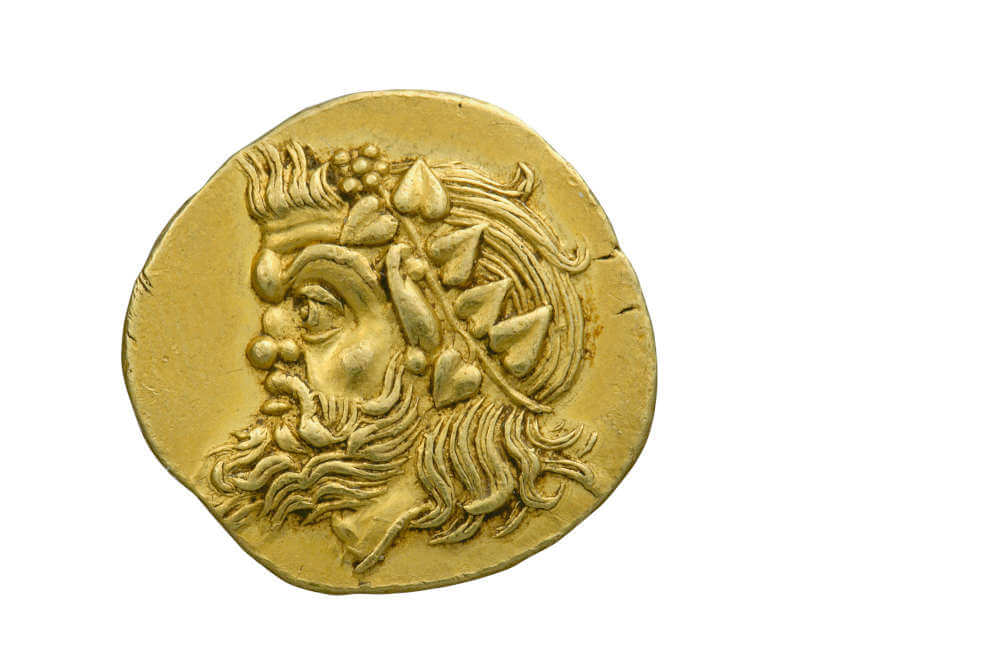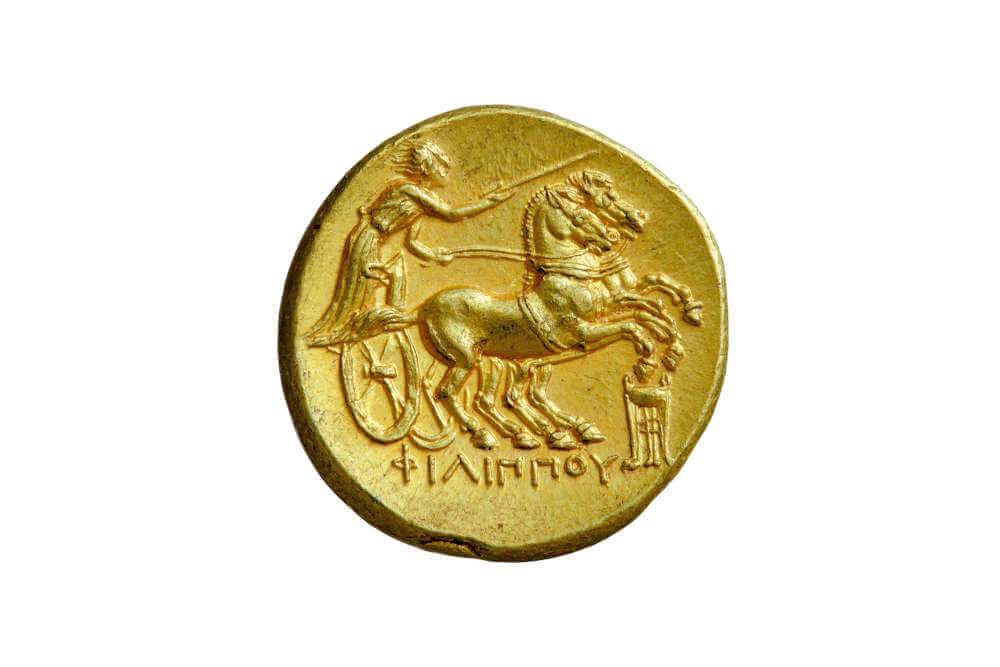50 Years of Alpha Bank Numismatic Collection: “The Other Side of the Coin”
To celebrate the 50th anniversary of the creation of the world-famous Alpha Bank Numismatic Collection, the Bank organizes the major retrospective exhibition “The Other Side of the Coin”, at the Museum of the Basil & Elise Goulandris Foundation, Athens.
Content
The exhibition pays tribute to the memory of Yannis S. Costopoulos, whose inspiration and vision were the driving forces behind the creation and growth of the Alpha Bank Numismatic Collection, and is scheduled to run from May 3 to July 23, 2023.
At the Press conference held on May 2 at the auditorium of the Basil & Elise Goulandris Foundation, Athens, the Chairman of the Board of Directors of Alpha Bank, Mr. Vasileios Rapanos, spoke with great emotion about the exhibition’s anniversary and its symbolic character:
“After a period of suspension of all cultural events due to the pandemic, we resume our cultural activities with an exhibition of high symbolic value. An exhibition that celebrates the completion of 50 years of the Bank’s Numismatic Collection and is dedicated to the man who laid the foundation stone for its creation, the pioneer and visionary, Yannis Costopoulos.”
In his brief address, Mr. Rapanos gave a summary account of the Numismatic Collection’s evolution and, referring to the cultural initiatives and actions undertaken by the Bank today, he stressed: “As the guardian of this invaluable treasure, the Alpha Bank of the new era, “with vision and with wisdom”, as our late Chairman Yannis Costopoulos used to say, continues to contribute to our country’s cultural life, seeking to enhance the intellectual, ethical and educational standards of society.”
For his part, the Manager of the Communication and Corporate Affairs Division, Mr. George Terzis, said:
“The exhibition we are inaugurating today marks an important moment in Alpha Bank’s history, in terms of its relationship with Culture. A multifaceted relationship that covers art, history, currency. A relationship that began with Yannis Costopoulos – man, visionary, banker – and continues to this day by the Bank’s Management without interruption.”
The Subject of the Exhibition
The coin outlines the historical and cultural character of a people in a given place and time, offering rich material to anyone wishing to explore the various aspects of the past. It is the basic means of transaction, making its appearance in the second half of the 7th century BC.
The Exhibition of Alpha Bank’s Numismatic Collection, however, presents the other side of the coin – the one that makes it a means of communication and dissemination of messages, transforming it into a “snapshot” capturing faces and images in history and making it an object of art that reflects the artistic tendency and creative ability of its engravers, at the specific time when it was put into circulation. The exhibition presents 150 coins, all of which belong to the Bank’s Collection. These are minted in gold, silver and copper, and also include some particularly rare ones.
In his brief address during the Press Conference, Mr. Kyriakos Koutsomallis, General Manager of the Basil & Elise Goulandris Foundation, referred to the exhibition’s original approach to the presentation of coins, noting the following:
“The tribute we have the privilege to host, in addition to contributing to the preservation of the unity of historical, intellectual and artistic time, also offers aesthetic, iconographic narratives concerning figures, mythical portraits and myths, promoting numismatic research.
It is an original approach and reading of the coin that broadens the reading narrative and offers valuable material to numismatic scientific research. It makes it easier for both the initiated and the less familiar visitor to understand the messages that are relevant and address big and crucial questions that concern people and society at large.”
As the Curator of the Bank’s Numismatic Collection, Dr Dimitra Tsangari, stressed:
“The Alpha Bank Numismatic Collection, which has already completed 50 years of dynamic presence in the global numismatics scene, is part of our national cultural heritage.
It is a part of Greece, as envisioned by Yannis Costopoulos already in 1972. The man who worshipped the ancient coin, not only as a basic means of transaction, but also as historical evidence. Today we highlight the Other Side of the Coin, the one that turns it into a snapshot of a moment in history, a means of communication and a masterpiece of ancient Greek art.”
The Sections of the Exhibition
The coins exhibited depict figures and narrate events from Greek mythology and – primarily – from the historical period of Greek antiquity, but also from Roman and Byzantine times.
The first section is dedicated to the Sphere of Myth. It presents a fascinating world of gods, heroes, mythical figures and beings that was a primary source of inspiration for coin engravers. Cities and sovereigns, in different regions and time periods, use Figures from the realm of myth and illustrated Mythical Stories, associated with religious faith and worship, the projection of the heroic past in the case of cities, and political propaganda in the case of rulers. In this way, numismatic iconography functions as a visual, communicative medium and serves religious, national, political and dynastic purposes.
The second section, following the Course of History, highlights Historical Personalities and images of Historical Events associated with each issuing authority. The face of the sovereign on the coin was used as the epitome of his virtues and merits and as a reminder of his hereditary right to power. At the same time, an image from a specific historical event narrates the political and historical context of the time.
The third section closes the narrative and presents coins with Snapshots of human activity and Images from nature. This final section complements the wealth of monetary iconography, the countless sources of inspiration of ancient engravers and their ability, using simple means and drawing on their imagination, to transform the coin into an image of their lives and imprint on it the world around them.
A video of 20 selected coins, shown in motion and in magnification and allowing the visitor to observe both their sides, is also screened in this room.
The Timeline of the Alpha Bank Numismatic Collection
In a specially configured room of the exhibition area, the Timeline of the Bank’s Numismatic Collection is presented, highlighting the major milestones in the Collection’s progress, using as evidence selected documents and photographs that have marked its evolution. Documents and publications of the Collection are exhibited in a showcase, together with the ancient coin of the island of Aegina – the silver stater, which dates back to the 5th century B.C. and was the inspiration for Alpha Bank’s logo. In the same room, a short film is screened presenting the most important moments in the evolution of the Numismatic Collection.
The Educational Program
An educational space for young visitors has also been created at the Exhibition, where digital games related to the coins are presented, together with the Numismatic Collection’s educational programs in the form of a “museum suitcase”. In the educational area of the Exhibition, the film “Coin: Appearance-Evolution-Production” is screened, which refers to the history of the coin, from the time of its appearance and throughout antiquity.
An Exhibition Accessible to All
It is also important to note that with the Exhibition, Alpha Bank sends an important message of inclusion, as – in line with its Social Responsibility strategy – it delivers on its commitment to equal access to culture for all. Thus, in collaboration with the Lighthouse for the Blind of Greece and the Panhellenic Association of Paraplegics, the exhibition “The Other Side of the Coin” is fully accessible to people with visual and mobility impairments and disabilities, constituting another major initiative of the Bank to raise public awareness of respect for diversity and the elimination of inequalities.
The Exhibition Catalogue
The exhibition is accompanied by a detailed, richly illustrated catalogue in Greek and English. The catalogue includes addresses by Ute Wartenberg Kagan, President of the International Numismatic Council, President – Scientific Curator of the American Numismatic Society, Katerini Liampi, Professor Emeritus of the University of Ioannina, Vasileios Rapanos, Chairman of the Board of Directors of Alpha Bank, and Vassilios Psaltis, Alpha Bank Group CEO.
Here you can find further information on the exhibition.
Learn more about the outstanding coin collection of the Alpha Bank.
When you visit the exhibition in Athens, you should consider visiting the Numismatic Museum too!
























